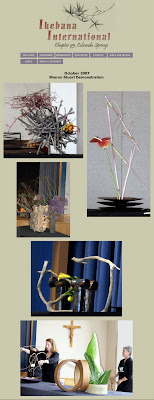Ikebana—The Way of Flowers
Japanese Flower Arranging
Ikebana changed my life. The first time I saw an Ikebana installation at a meditation center, it took my breath away—a transcendent experience. My heart was opened. While I have studied with many Buddhist teachers and will always live my life according to the philosophies, Ikebana is my main practice, my meditation, my heart.
Ikebana—the art of flower arrangement—was brought to Japan in the sixth century by monks offering flowers to the Buddha. In ancient times it was controlled by priests of the major temples and practiced by royalty and samurai warriors to add spiritual balance to their lives. Previously secret and unavailable to the populace, this art has recently been made available to people in all walks of life. Today, Ikebana is one of the most well known and actively practiced of Japan’s traditional arts. It is a Zen-like awareness practice creating a living sculpture—a hands-on practice, not a subject.
Ikebana has emerged from the traditional setting of the tokonoma—the alcove of the Japanese house—to include arrangements harmoniously designed to fit virtually any environment. In fact, Ikebana installations are considered a vital element in the contemporary art world.
There are many schools of Ikebana, each with their own fundamentals. The essential elements of the basic form remain transcendent: three main lines representing Heaven, Man, and Earth respectively. This is best understood by a quote from a Chinese flower-master of the Confucian era, “one line is symbolic, two are harmonious, but three lines represent fulfillment.”
Sofu Teshigahara founded the Sogetsu School of Ikebana in 1933 - the school I train with. A sculptor of international repute, Teshigahara brought expansiveness to Ikebana, opening new possibilities by adding unusual materials to create abstract and avant-garde work. Emphasis is placed on linear perfection, color, space and balance. It is this work that has captured me for a decade and a half, and has made me a life-long student.
There is a famous Eastern quote that says, “When you are ready, the teacher will appear.”
During the time I was struggling with the loss of my mother and my two brothers, I found my Ikebana teacher, Kyoko Kita, Master Teacher, Sogetsu School. She had moved from Japan to the Rocky Mountains where she started the Colorado Branch of Sogetsu. Every Monday, I drove to Denver to practice and study with Mrs. Kita at her home. Over time, this gentle, slow process of working with plant and other organic materials to create something of living beauty began to transform me. As I deepened my practice, I realized that the art of Ikebana is a metaphor for our own lives: flowers, like us, live and die.
After three years working every week with Mrs. Kita, she sent me a holiday card thanking me for coming such a long way to study, and wrote, “and now your work is good.” This is the nature of practice—it takes time and reflection, then more time. Eventually it is good.
The beauty of Ikebana is that it can be approached from many levels. For some people, it is enough to spend time making attractive flower arrangements. For others who seek to embrace the subtleties of the art, it can be a much deeper experience. Ikebana teaches you to be still and out of that stillness you learn about yourself. It is an awareness practice that changes the way we see everything. And is also an art that teaches patience and forgiveness, and ultimately these principles become incorporated into everyday life.
It has been over 15 years since my first awakening, and with even more losses in my life,
Ikebana still remains my ground. I continue to study with Kyoko Kita, and have traveled to Japan, as well as other cities around this country, to take advanced workshops with Master Sogetsu teachers. I have completed nine levels in the Sogetsu School and have received certification as First Somu, Master Teacher. I am actively involved in the Colorado Branch annual Ikebana exhibits and demonstrations. I offer introductory workshops every month, in addition to holding regular classes for ongoing students at all levels in the Fort Collins area.
Sharon Stuart, Sensei
If you are interested in attending a workshop or class, please call Sharon Stuart at 970-221-0983.


